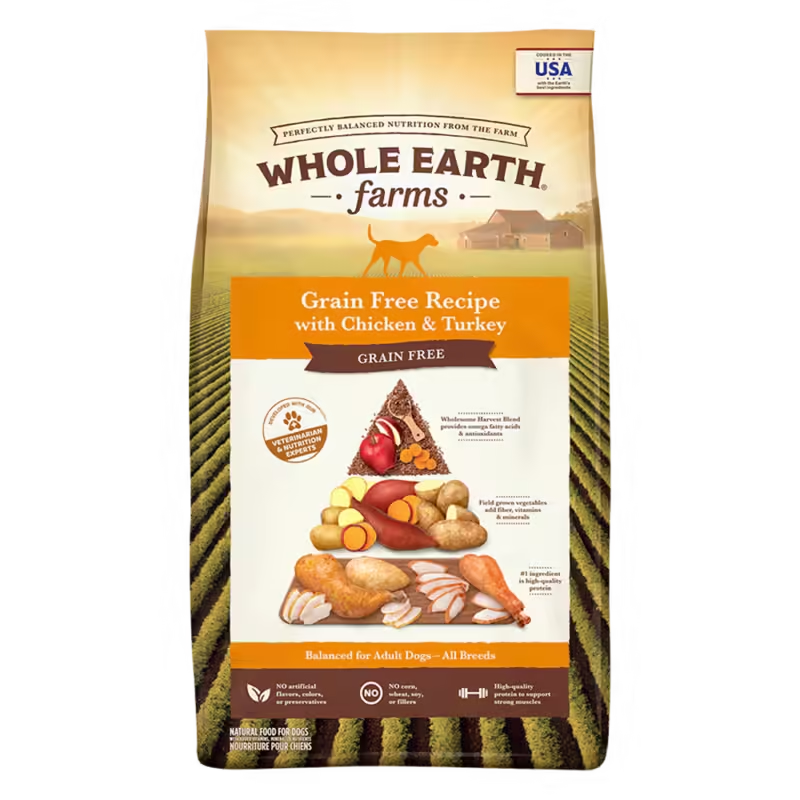Skin Allergies: What to Look For and How to Choose the Best Dog Food in 2024
Is your furry friend constantly scratching and itching? Skin allergies can be a real pain for our canine companions, but the right diet can make all the difference. We’ve researched the top dog foods for…
Is your furry friend constantly scratching and itching? Skin allergies can be a real pain for our canine companions, but the right diet can make all the difference. We’ve researched the top dog foods for skin allergies to help you find the perfect solution for your pup.
When it comes to managing skin allergies in dogs, choosing the right food is crucial. We’ll guide you through what to look for in dog food that can soothe your pet’s irritated skin and provide relief from allergies. From hypoallergenic ingredients to essential nutrients, we’ll cover everything you need to know to make an well-informed choice about your dog’s diet.
Understanding Dog Food Allergies
Dog food allergies occur when a dog’s immune system overreacts to exact ingredients in their food. These allergies can cause various uncomfortable symptoms and affect a dog’s overall health and well-being.
Common Food Allergens in Dogs
Dogs can develop allergies to various food ingredients, but proteins are the most common culprits. Here’s a list of frequent allergens:
- Beef
- Chicken
- Lamb
- Dairy products
- Eggs
- Wheat
- Soy
- Corn
- Fish
Novel proteins, such as venison or duck, can also trigger allergies if the dog has been previously exposed. It’s crucial to identify the exact allergen causing the reaction, often through an elimination diet or by changing the protein source. Working with a veterinarian to determine the exact allergen is essential for effective management of food allergies in dogs.
Symptoms of Food Allergies vs. Sensitivities
Food allergies and food sensitivities in dogs can present similar symptoms, but they’re distinct conditions:
Food Allergies:
- Skin irritation (redness, itching, hot spots)
- Chronic ear infections
- Gastrointestinal issues (vomiting, diarrhea)
- Respiratory problems (coughing, wheezing)
- Swelling of face, ears, lips, eyelids, or earflaps
Food Sensitivities:
- Intermittent gastrointestinal upset
- Soft stools or diarrhea
- Excessive gas
- Occasional vomiting
- Weight loss or difficulty maintaining weight
The primary difference is that food allergies involve an immune system response, while sensitivities don’t. Allergies often cause more severe and persistent symptoms, particularly skin-related issues. Sensitivities typically result in milder, primarily digestive symptoms. Accurate diagnosis is crucial for proper treatment and management of both conditions.
Key Factors to Consider in Hypoallergenic Dog Food
When selecting hypoallergenic dog food for skin allergies, it’s crucial to focus on exact factors that can help alleviate your dog’s symptoms. We’ll explore three key elements to look for in hypoallergenic dog food: novel protein sources, limited ingredient diets, and grain-free options.
Novel Protein Sources
Novel protein sources are essential in hypoallergenic dog food for skin allergies. These proteins are typically unfamiliar to your dog’s immune system, reducing the likelihood of an allergic reaction. Common novel proteins include:
- Duck
- Salmon
- Venison
- Kangaroo
- Alligator
For example, Blue Buffalo’s Natural Veterinary Diet NP Novel Protein Alligator uses alligator as its primary protein source. This unique option can be particularly effective in managing food allergies in dogs. By introducing a protein your dog hasn’t been exposed to before, you’re giving their system a chance to reset and potentially avoid triggering an allergic response.
Limited Ingredient Diets
Limited Ingredient Diets (LIDs) are formulated with a minimal number of ingredients, typically featuring a single protein source and a single carbohydrate source. This approach simplifies the process of identifying and avoiding exact allergens that may be causing your dog’s skin issues. Benefits of LIDs include:
- Easier allergen identification
- Reduced risk of cross-contamination
- Simplified digestion
Wellness Simple Turkey & Potatoes is an example of a limited ingredient diet that has shown improvement in dogs with skin allergies. By restricting the number of ingredients, these diets make it easier for you to pinpoint and eliminate potential allergens from your dog’s food, potentially leading to important improvements in their skin condition.
Grain-Free Options
Grain-free dog foods have gained popularity as an alternative for dogs with skin allergies. While not all dogs are allergic to grains, some may benefit from a grain-free diet. Key aspects of grain-free options include:
- Alternative carbohydrate sources (e.g., sweet potatoes, peas)
- Higher protein content
- Potential reduction in inflammatory ingredients
It’s important to note that grain-free diets aren’t necessary for all dogs with skin allergies. Some dogs may be allergic to exact grains, while others may have no issues with grains at all. Consult with your veterinarian to determine if a grain-free diet is appropriate for your dog’s exact needs. When considering grain-free options, focus on high-quality ingredients and balanced nutrition to ensure your dog receives all the essential nutrients for healthy skin and coat.

Types of Dog Food for Allergies
When addressing skin allergies in dogs, it’s crucial to choose the right type of food. We’ll explore various options, including dry kibble, wet food, and fresh and raw diets, to help you find the best solution for your furry friend’s skin sensitivities.
Dry Kibble
Dry kibble offers several hypoallergenic options for dogs with skin allergies. Look for foods with novel proteins like salmon, venison, or alligator, which are less likely to trigger allergic reactions. Natural Balance Limited Ingredient Diet Salmon & Brown Rice and Blue Buffalo Basics Salmon and Potato Recipe are excellent examples. Hydrolyzed protein foods, such as Royal Canin Veterinary Diet Adult Ultamino and Hill’s Prescription Diet d/d Skin/Food Sensitivities, break down proteins into smaller pieces, reducing the risk of allergic responses. When selecting dry kibble, avoid common allergens like chicken, beef, wheat, soy, and dairy. Opt for limited ingredient diets to simplify allergen identification and minimize potential triggers for your dog’s skin allergies.
Wet Food
Wet food can be an excellent option for dogs with skin allergies due to its higher moisture content, which helps maintain hydration and skin health. Look for hypoallergenic wet food formulas that use novel proteins and limited ingredients. Some brands offer grain-free options, which may benefit dogs sensitive to common grains. When selecting wet food, prioritize products with high-quality, easily digestible proteins and avoid artificial preservatives, colors, and flavors.
Consider options like canned venison and sweet potato or duck and pea formulas. Wet food can be used as a standalone diet or mixed with hypoallergenic dry kibble to provide variety and additional moisture. Always introduce new foods gradually to monitor your dog’s response and consult with your veterinarian for personalized recommendations.
Fresh and Raw Diets
Fresh and raw diets can be beneficial for dogs with skin allergies, as they often contain fewer processed ingredients and preservatives. These diets typically consist of high-quality proteins, fruits, and vegetables, allowing for better control over ingredients. When considering a fresh or raw diet, opt for novel protein sources like rabbit, duck, or fish to reduce the risk of allergic reactions.
Some commercial fresh food brands offer limited ingredient options specifically designed for dogs with allergies. If preparing homemade meals, consult with a veterinary nutritionist to ensure a balanced diet. Raw diets may include uncooked meats, bones, and organs, but require careful handling to prevent bacterial contamination. Always introduce fresh or raw diets gradually and monitor your dog’s skin condition for improvements.
Nutritional Considerations for Allergic Dogs
When selecting dog food for skin allergies, it’s crucial to focus on balanced nutrition and exact ingredients that support skin health. We’ll explore key nutritional factors and supplements that can help manage skin allergies in dogs.
Balanced Nutrition
Dogs with skin allergies require a well-balanced diet to support their overall health and immune system. We recommend looking for dog foods that contain:
- High-quality protein sources: Novel proteins like salmon, lamb, or venison are often less likely to trigger allergic reactions.
- Essential fatty acids: Omega-3 and omega-6 fatty acids help reduce inflammation and promote healthy skin and coat.
- Limited ingredients: Fewer ingredients make it easier to identify and avoid potential allergens.
- Easily digestible carbohydrates: Sweet potatoes or brown rice are good options for dogs with sensitive stomachs.
- Antioxidants: Vitamins A, C, and E support the immune system and skin health.
Foods like Wellness Simple Turkey & Potatoes and Blue Buffalo Basics Salmon and Potato Recipe offer balanced nutrition with limited ingredients, making them excellent choices for allergic dogs.
Supplements for Skin Health
Plus to a balanced diet, certain supplements can help improve skin health in dogs with allergies:
- Fish oil: Rich in omega-3 fatty acids, fish oil reduces inflammation and supports a healthy coat.
- Probiotics: These beneficial bacteria support gut health, which is closely linked to skin health and immune function.
- Zinc: This mineral plays a crucial role in skin healing and maintaining a healthy coat.
- Vitamin E: A powerful antioxidant that supports skin health and helps reduce inflammation.
- Biotin: Promotes healthy skin and coat growth, especially beneficial for dogs with dry or flaky skin.
When considering supplements, it’s essential to consult with a veterinarian to determine the appropriate dosage and ensure they don’t interact negatively with any medications or existing health conditions.
How to Identify the Right Food for Your Dog
Identifying the right food for dogs with skin allergies requires careful consideration and patience. We’ll explore two effective methods to help pinpoint the most suitable diet for your allergic pup.
Elimination Diets
Elimination diets are a systematic approach to identifying food allergens in dogs. Here’s how they work:
- Start with a novel protein and carbohydrate source
- Feed this diet exclusively for 8-12 weeks
- Monitor symptoms for improvement
- Gradually reintroduce potential allergens one at a time
- Observe any allergic reactions
Common novel protein options include venison, duck, and fish. For carbohydrates, consider sweet potatoes or peas. Limited ingredient diets like Wellness Simple Turkey & Potatoes or Natural Balance Limited Ingredient Diet Salmon & Brown Rice are excellent choices for elimination diets. These foods minimize the risk of allergic reactions while providing essential nutrients.
Consult with a Veterinarian
Consulting a veterinarian is crucial when addressing your dog’s skin allergies. Here’s why:
- Professional diagnosis: Vets can differentiate between food allergies and other skin conditions
- Customized advice: They provide recommendations based on your dog’s exact needs
- Nutritional guidance: Ensure your dog receives balanced nutrition while managing allergies
- Monitoring: Regular check-ups help track progress and adjust treatment plans
Veterinarians may recommend hydrolyzed protein diets, such as Blue Buffalo Natural Veterinary Diet NP Novel Protein Alligator. These diets contain proteins broken down into small, unrecognizable pieces, reducing the likelihood of an allergic response. They’ll also guide you through the elimination diet process, ensuring it’s conducted safely and effectively.
Top Features to Look for in Allergy-Friendly Dog Food
When selecting dog food for skin allergies, it’s crucial to prioritize exact features that cater to your pet’s sensitivities. We’ll explore the key elements to consider when choosing allergy-friendly dog food, focusing on ingredients, allergen avoidance, and digestibility.
High-Quality Ingredients
High-quality ingredients form the foundation of allergy-friendly dog food. We recommend looking for:
- Novel protein sources like venison, salmon, or alligator, which are less likely to trigger allergies compared to common proteins
- Foods rich in omega-3 and omega-6 fatty acids from sources such as fish oil, flaxseed, and salmon to support skin health and reduce inflammation
- Antioxidants and essential vitamins and minerals to boost overall health and skin condition
- Limited ingredient diets that simplify allergen identification and digestion
- Grain-free options that provide alternative carbohydrate sources and higher protein content
By choosing dog food with these high-quality ingredients, we can help minimize allergic reactions and promote better skin health for our canine companions.
Avoiding Common Allergens
Identifying and avoiding common allergens is crucial when selecting dog food for skin allergies. We suggest:
- Opting for foods that exclude common allergens such as beef, chicken, lamb, wheat, soy, eggs, corn, and nuts
- Considering hydrolyzed protein diets, where proteins are broken down into smaller pieces, reducing the risk of allergic reactions
- Selecting novel protein sources that your dog hasn’t been exposed to previously
- Reading ingredient labels carefully to ensure potential allergens are not hidden under different names
- Choosing limited ingredient diets to minimize the chance of exposure to multiple allergens
By being vigilant about avoiding common allergens, we can significantly reduce the risk of triggering allergic reactions in our sensitive dogs.
Digestibility and Absorption
Ensuring optimal digestibility and nutrient absorption is essential for dogs with skin allergies. We recommend focusing on:
- Easily digestible carbohydrates like sweet potatoes or pumpkin
- High-quality, single-source proteins that are easier for dogs to process
- Wet food options with higher moisture content, which can aid digestion
- Probiotics to support gut health and improve nutrient absorption
- Foods with added digestive enzymes to enhance the breakdown of nutrients
- Avoiding artificial preservatives, colors, and flavors that may irritate sensitive digestive systems
By prioritizing digestibility and absorption, we can help our dogs with skin allergies get the most nutritional benefit from their food while minimizing potential irritants.
Transitioning to a New Diet
When introducing a new diet to manage your dog’s skin allergies, it’s crucial to approach the process carefully. A gradual transition helps minimize digestive upset and allows you to monitor your dog’s response effectively.
Gradual Introduction
Introducing a new diet for dogs with skin allergies requires a methodical approach. Start by mixing a small amount of the new food with your dog’s current diet, gradually increasing the proportion over 7-10 days. Begin with 25% new food and 75% old food for the first 2-3 days. Then, progress to a 50/50 mix for the next 2-3 days, followed by 75% new food and 25% old food for another 2-3 days. Finally, transition to 100% new food. This slow introduction allows your dog’s digestive system to adapt, reducing the risk of gastrointestinal issues.
Monitoring Your Dog’s Response
Closely observe your dog’s reaction to the new diet. Look for improvements in skin condition, such as reduced itching, redness, or inflammation. Monitor for any adverse reactions, including vomiting, diarrhea, or increased scratching. Keep a daily log of your dog’s symptoms, energy levels, and stool consistency. If you notice any concerning changes, consult your veterinarian immediately. It may take 8-12 weeks to see important improvements in skin allergies, so patience is key. During this time, avoid introducing new treats or supplements that could interfere with your observations. Regular check-ins with your vet can help ensure the new diet is effectively addressing your dog’s skin allergies.
Conclusion
Choosing the right dog food for skin allergies requires careful consideration and patience. We’ve explored various options including novel proteins limited ingredient diets and grain-free formulas. Remember that each dog is unique and what works for one may not work for another. It’s crucial to work closely with your veterinarian throughout the process. By selecting the appropriate diet and monitoring your dog’s progress you can help alleviate skin allergy symptoms and improve your furry friend’s overall quality of life. Stay committed to finding the best solution for your dog’s exact needs.

